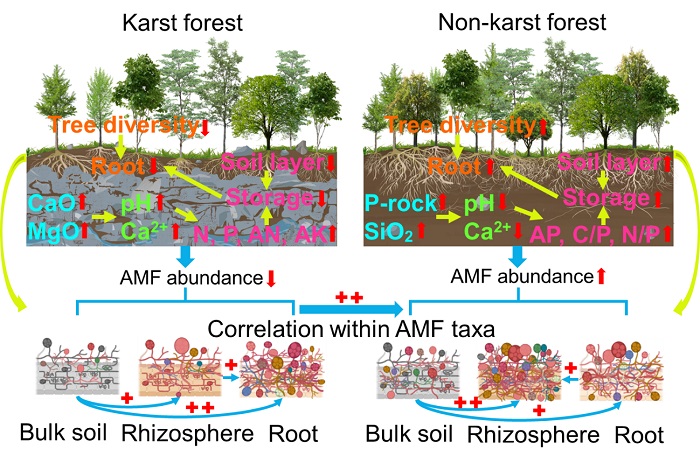Lithology and Niche Habitat Effectively Control Arbuscular Mycorrhizal Fungi
Karst landscapes are distributed worldwide, with the karst region in southwest China accounting for 5.8% of the national land area. The differing chemical properties of bedrock between karst carbonate rocks and non-karst clastic rocks are significant factors influencing the arbuscular mycorrhizal fungi (AMF) community by altering soil properties and plant diversity. The researcher group of Prof. Wang Kelin from the Institute of Subtropical Agriculture (ISA) of the Chinese Academy of Sciences (CAS) most recently found that lithology and niche habitat have significant effect on arbuscular mycorrhizal fungal abundance and their interspecific interactions
In their study published in SCI TOTAL ENVIRON on Feb.9, the researchers conducted a detailed study to assess the alterations in the composition and diversity of AMF communities across bulk soil, rhizosphere soil, and roots in both karst and non-karst forests. Karst carbonate rocks elevated soil nitrogen (N) and phosphorus (P) levels compared to non-karst clastic rocks. This elevation can be attributed to a high rate of bedrock weathering and increased soil Ca2+ and Mg2+ content, as well as pH, which is facilitated by the high CaO content and Ca/Mg ratio found in the bedrock of karst forests. Nevertheless, non-karst forests with thicker soil layers exhibited superior soil nutrient storage, leading to greater tree diversity. This diversity, coupled with abundant root biomass and root exudates, contributed to higher AMF abundance and stronger interactions among AMF taxa in both bulk and rhizosphere soil of non-karst clastic rocks, compared to karst carbonate rocks (Fig. 1).
Additionally, the enhanced nutrient availability in rhizosphere soil and roots leads to an increase in AMF abundance and diversity compared to bulk soil. In this situation, a more complex network within AMF taxa was observed in rhizosphere soil and roots compared to bulk soil, owing to the increase in AMF abundance and diversity in rhizosphere soil and roots.
The results underscores the ecological significance of lithology and niche habitats in determining AMF community distribution, emphasizing their role in nutrient cycling and tree species coexistence. By recognizing the role of lithology and niche habitats in shaping AMF communities, we can better manage and conserve forest ecosystems, promoting plant growth, vegetation recovery, and sustainable development.
This study was funded by the Joint Funds of the National Natural Science Foundation of China, the National Natural Science Foundation of China, and the Youth Innovation Promotion Association of the Chinese Academy of Sciences Program.
More details could be found at https://www.sciencedirect.com/science/article/pii/S0048969724009136.
Contact: Wang Kelin
E-mail: kelin@isa.ac.cn

Conceptual model revealing the effect of lithology and niche habitat on AMF.(Image by Dan Xiao)
Download attachments: